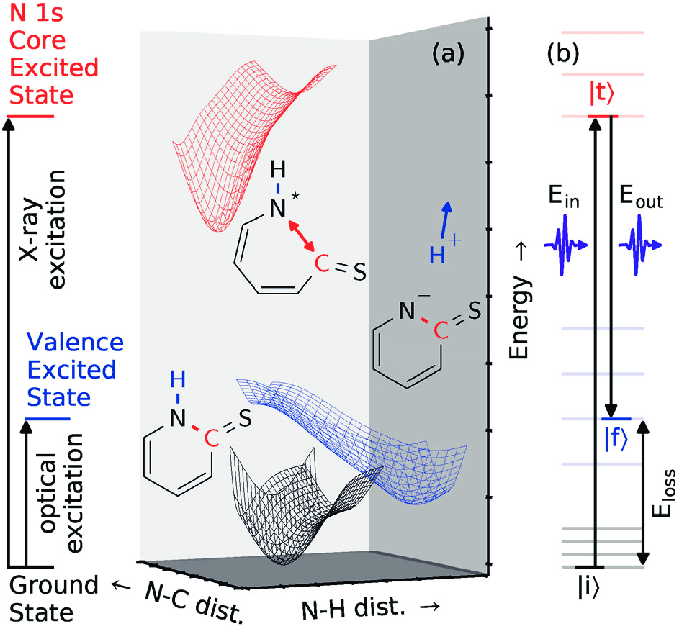Mapping Chemical Bonds, Frontier Orbitals

Mapping the evolution of frontier orbitals in a chemical reaction via time-resolved resonant inelastic X-ray scattering (RIXS) is a powerful new XFEL approach providing element-specific insight to the dynamics of chemical bonds and excited-state charge distributions.
As shown in Fig. 1, RIXS probes both occupied and occupied valence states from element-specific core levels (with resolution that is not limited by the core-hole lifetime broadening). Soft X-ray RIXS is particularly sensitive to the most abundant elements (carbon, nitrogen, oxygen) that comprise ligand structures, and to the d-electrons of abundant transition metals.
Pioneering ultrafast RIXS studies at LCLS have been combined with quantum chemical calculations to provide the first detailed mechanistic picture of frontier-orbital changes that drive excited-state dynamics of the model transition-metal complex Fe(CO)5, revealing that light-induced dissociation creates a previously unreported excited singlet species and its subsequent reactions (as shown in Fig. 1).1
These studies of large structural changes on model molecular systems at high concentrations (~1 M) demonstrate the potential of time-resolved RIXS to correlate orbital symmetry with spin multiplicity and reactivity in short-lived reaction intermediates.
Time-resolved RIXS spectroscopy is a powerful tool for mapping the dynamic frontier-orbital interactions with element-specificity and is expected to be widely applicable with sensitivity to subtle chemical changes in dilute samples with the sensitivity provided by LCLS-II. RIXS complements X-ray scattering approaches that probe the atomic structural changes associated with ultrafast chemical reactions.

Figure 2. Left: Measured RIXS intensity maps for Fe(CO)_5 (left) and photoproducts at a pump-probe delay of ~350 fs. Right: An electronically excited singlet state converts into a triplet state on a sub-picosecond time scale with concomitant formation of a singlet complex with the solvent. 1
Related LCLS time-resolved soft X-ray spectroscopy studies of metalloproteins and metal complexes, in solution and at room temperature, demonstrate the power of these methods for mapping changes in valence electronic structure (e.g. oxidation state, charge and spin densities) of catalytically-active metal centers in (bio) chemical reactions under functioning conditions.2
Ultrafast X-rays not only enable capturing transient states in reactive systems, but also avoid “X-ray damage”, i.e. subtle X-ray induced redox changes that are a significant issue for conventional X-ray studies, often limiting measurements to fixed robust samples at cryogenic temperatures.
The potential for time-resolved RIXS methods to reveal bonding dynamics in solvated complexes of low-Z elements is illustrated in studies of nitrogen compounds in which selective deformation of N-H and N-C chemical bonds in aqueous 2-thiopyridone is achieved by tailored excitation (as shown in Fig. 3).3 Such ultrafast photoinduced tautomerism and directional proton transfer processes are essential components of biological photo-protection mechanisms in DNA and melanin. They rely on ultrafast energy dissipation through photoinduced proton transfer states to outcompete other (detrimental) energy dissipation channels. In combination with multi-configurational quantum-chemical calculations, the orbital-specific electronic structure and associated ultrafast dynamics are accessed via N-1s RIXS and provide direct evidence for controlled ultrafast photoinduced molecular deformations.

Figure 3. Dynamics on excited-state potential energy surfaces (PES) of controlled deformation of bonds in 2-TP by resonant photo-excitation. Selective N deprotonation occurs on the VE-PES (blue) following photo excitation from the ground-state PES (black). 3
P. Wernet, K. Kunnus, I. Josefsson, et al., "Orbital-specific mapping of the ligand exchange dynamics of Fe(CO)5 in solution", Nature 520, 78 (2015).
M. Kubin, J. Kern, S. Gul, et al., "Soft x-ray absorption spectroscopy of metalloproteins and high-valent metal-complexes at room temperature using free-electron lasers", Structural Dynamics 4, 054307 (2017).
S. Eckert, J. Norell, P. S. Miedema, et al., "Ultrafast Independent N−H and N−C Bond Deformation Investigated with Resonant Inelastic X-Ray Scattering", Angew. Chem. Int. Ed. 56, 6088 (2017).
